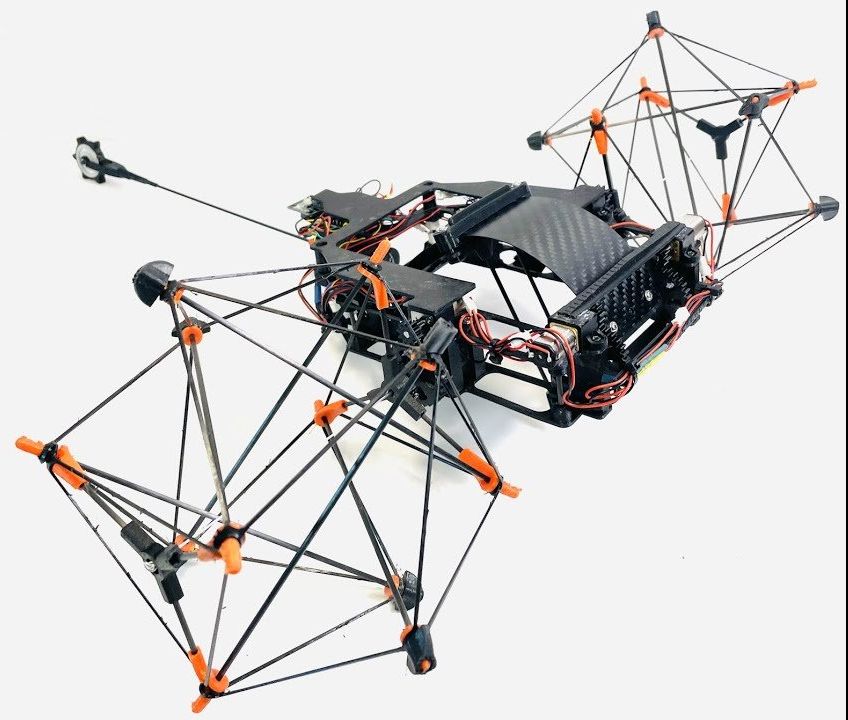Video Friday: Tensegrity Wheels

Video Friday is your weekly selection of awesome robotics videos, collected by your friends at IEEE Spectrum robotics. We also post a weekly calendar of upcoming robotics events for the next few months. Please send us your events for inclusion.
Enjoy today's videos!
We leverage tensegrity structures as wheels for a mobile robot that can actively change its shape by expanding or collapsing the wheels. Besides the shape-changing capability, using tensegrity structures as wheels offers several advantages over traditional wheels of similar size, such as shock-absorbing capability without added mass, since tensegrity wheels are both lightweight and highly compliant. The robot can also jump onto obstacles up to 300 millimeters high with a bistable mechanism that can gradually store but quickly release energy.
Meet GE Aerospace's Sensiworm (Soft ElectroNics Skin-Innervated Robotic Worm), a highly intelligent, acutely sensitive soft robot that could serve as extra sets of eyes and ears inside the engine for aerospace service operators. Deploying self-propelling, compliant robots like Sensiworm would give operators virtually unfettered access in the future to perform inspections without having to disassemble the engine.
[ GE ]
Why not Zoidberg?
[ Boston Dynamics ]
Traditional AI methods take several weeks, days, or hours to teach a walking robot how to walk. This becomes impractical. This study overcomes the problem by introducing a novel, bio-inspired integrative approach to develop neural locomotion control that enables a stick-insect-like walking robot to learn how to walk within 20 seconds! The study not only proposes a solution for neural locomotion control but also enables insights into the neural equipment of the biological template. It also provides guidance for further developing advanced bio-inspired theory and simulations.
[ VISTEC ]
Thanks, Poramate!
At Hello Robotics, we are redefining the way humans and robots interact. Our latest creation, MAKI Pro, embodies our belief in empathic design-a principle that prioritizes the emotional and social dimensions of technology. MAKI Pro offers unique features such as animatronic eyes for enhanced eye contact, an embedded PC, and 17 points of articulation. Its speech capabilities are also powered by ChatGPT, adding an element of interaction that's more natural. The compact design allows for easy placement on a desktop.
[ Hello Robotics ]
Thanks Tim!
During the RoboNav project, autonomous driving tests were conducted in the Seetal Alps, in Austria. The tracked Mattro Rovo3 robot autonomously navigates to the selected goal within the operational area, considering alternative paths and making real-time decisions to avoid obstacles.
Thanks, Lena!
NASA's moon rover prototype completed lunar lander egress tests.
[ NASA ]
In the early days of Hello Robot, Aaron Edsinger and Charlie Kemp created several prototype robots and tested them. This video from 24 November 2017 was taken as Charlie remotely operated a prototype robot in his unoccupied Atlanta home from rural Tennessee to take care of his family's cat. Charlie remotely operated the robot on 23, 24, 25, and 26 November. He successfully set out fresh food and water for the cat, put dirty dishes in the sink, threw away empty cat food cans, and checked the kitty litter.
[ Hello Robot ]
For a robot that looks nothing at all like a bug, this robot really does remind me of a bug.
[ Zarrouk Lab ]
Teaching quadrupedal robots to shove stuff, which actually seems like it might be more useful than it sounds.
[ RaiLab Kaist ]
The KUKA Innovation Award competition has been held annually since 2014 and is addressed to developers, graduates, and research teams from universities or companies. For this year's award, the applicants were asked to use open interfaces in our newly introduced robot operating system, iiQKA, and to add their own hardware and software components. Ultimately, Team JARVIS from the Merlin Laboratory of Politecnico di Milano, in Italy, was able to assert itself as winner. With its plug-and-play method for programming collaborative robotics applications, which is fully integrated into the iiQKA ecosystem, it convinced the jury.
[ Kuka ]
Once a year, the FZI Research Center for Information Technology (FZI Forschungszentrum Informatik) offers a practical course for students at the Karlsruhe Institute of Technology (KIT) to learn about biologically motivated robots. During the practical course, student teams develop solutions for a hide-and-seek challenge in which mobile robots (Boston Dynamics' Spot, ANYbotics' ANYmal, Clearpath Robotics' Husky) must autonomously hide and find each other.
[ FZI ]
A couple of IROS 35th-anniversary plenary talks from Kyoto last year, featuring Marc Raibert and Roland Siegwart.
[ IROS ]
Are robots on the verge of becoming humanlike and taking over most jobs? When will self-driving cars be cost-effective? What challenges in robotics will be solved by large language models and generative AI?
Although renowned roboticist Ruzena Bajcsy recently retired from Berkeley, she will return to discuss her insights on how robotics research has evolved over the past half century with five senior colleagues who have a combined research experience of over 200 years.
[ Berkeley ]